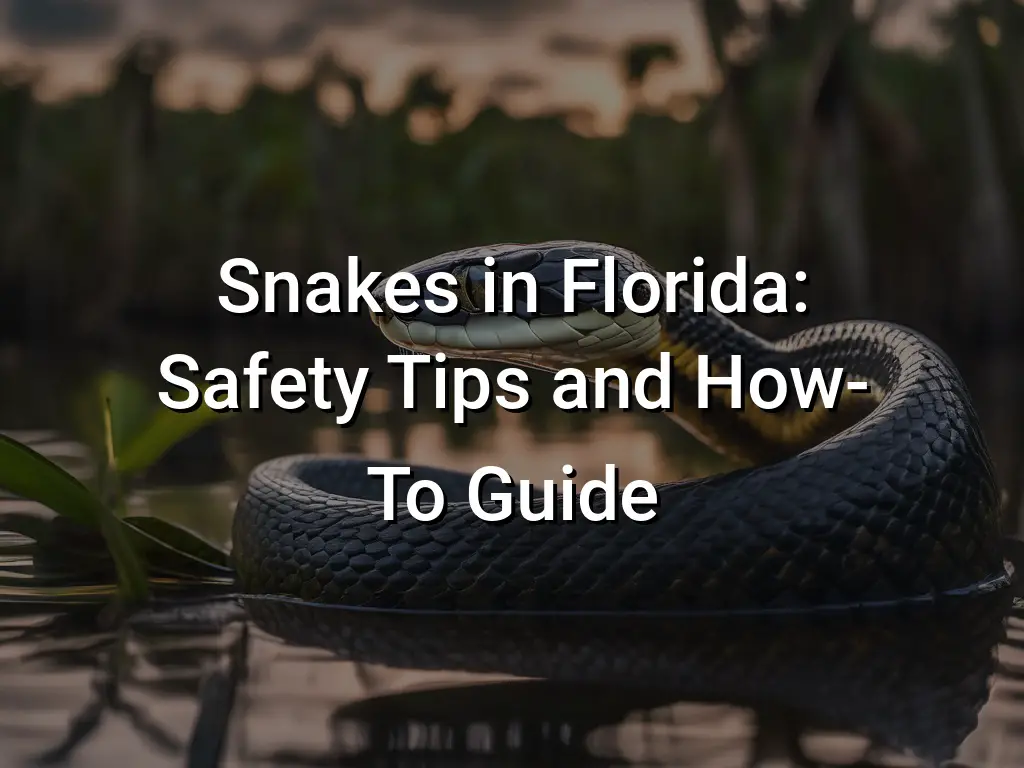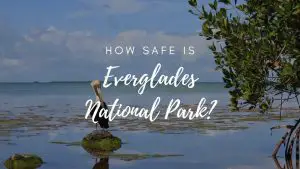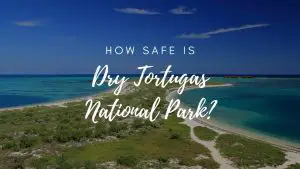Snakes in Florida: Safety Tips and How-To Guide

Florida, known for its subtropical climate and diverse ecosystem, is home to a wide variety of snake species. While snakes may evoke fear in some, it’s important to understand how to coexist with these fascinating creatures safely. In this article, we will provide you with the essential safety tips, identification methods, and steps to take in case of a snake bite, so you can navigate the snake-filled landscapes of Florida with confidence.
From identifying venomous snakes to learning how to prevent them from entering your property, we’ll cover it all. We’ll also explore the common non-venomous snakes you may encounter in Florida and discuss ways to peacefully coexist with these slithering neighbors. So, read on to discover the ultimate guide to safely interact with and appreciate the serpents of the Sunshine State!
Quick Links
Identifying Venomous Snakes
When it comes to snakes in Florida, it’s important to be able to identify venomous species to ensure your safety. Here are some key characteristics to look out for:
- Pit Vipers: Pit vipers, such as the Eastern Diamondback Rattlesnake, have triangular-shaped heads, vertical pupils, and heat-sensing pits between their eyes and nostrils.
- Rattlesnakes: Rattlesnakes are known for their distinctive rattles, which they use as a warning signal. They have a series of rattles at the end of their tails.
- Coral Snakes: Coral snakes have brightly colored bands of red, yellow, and black. Remember the rhyme, “Red touches black, friend of Jack; red touches yellow, kill a fellow” to help distinguish them from harmless snakes.
If you encounter a snake and are unsure if it is venomous, it’s best to maintain a safe distance and avoid disturbing it. It’s always better to err on the side of caution and assume any snake you encounter is potentially dangerous.
Safety Tips for Snakes Encounters
Encountering a snake can be a nerve-wracking experience, especially if you’re unsure whether it’s venomous or not. Here are some safety tips to keep in mind when encountering snakes in Florida:
- Stay calm: While it’s natural to feel scared or startled when you see a snake, it’s important to remain calm. Most snakes in Florida are non-venomous and pose no immediate threat to humans.
- Keep your distance: Maintain a safe distance from the snake. Snakes will usually try to avoid humans if given the opportunity, so give them space and they will likely move away.
- Do not approach or provoke the snake: It’s important to remember that snakes are wild animals and may bite if they feel threatened. Do not try to handle or catch the snake.
- Watch your step: When walking in areas where snakes may be present, such as tall grass or wooded areas, make sure to watch your step and avoid stepping on or near any snakes.
- Wear protective clothing: If you’re venturing into snake-prone areas, it’s a good idea to wear long pants, closed-toe shoes, and avoid wearing sandals or flip-flops.
- Be cautious around water: Snakes are often found near bodies of water, so be extra cautious when swimming, boating, or fishing. Always be aware of your surroundings.
- Keep your pets leashed: If you’re out with your pets, make sure to keep them on a leash. This will help prevent them from encountering snakes and potentially getting bitten.
- Learn to identify venomous snakes: Familiarize yourself with the venomous snake species in Florida, such as the Eastern Diamondback Rattlesnake, the Cottonmouth, and the Coral Snake. Knowing how to identify them can help you take appropriate precautions.
- Teach children about snake safety: If you have children, educate them about snake safety. Teach them to stay away from snakes and to alert an adult if they see one.
- Report any snake sightings: If you come across a venomous snake or witness any snake behavior that is concerning, report it to your local pest control or wildlife agency. They can provide guidance and assistance.
By following these safety tips, you can minimize the risks associated with encountering snakes in Florida and ensure the safety of yourself and those around you.
What to Do if Bitten by a Snake
If you find yourself bitten by a snake in Florida, it’s important to stay calm and take immediate action. Follow these steps to ensure your safety:
- Step 1: Move away from the snake – It’s crucial to put some distance between yourself and the snake to prevent further bites.
- Step 2: Identify the snake – If possible, try to remember the snake’s appearance or take a photo. This information will help medical professionals determine the appropriate treatment.
- Step 3: Call for help – Dial emergency services or contact a nearby medical facility to inform them about your situation. Provide details about the snake if possible.
- Step 4: Stay still and immobilize the bitten area – Avoid unnecessary movement, as it can cause the venom to spread more quickly through your bloodstream. Keep the affected limb below the level of your heart and remove any tight clothing or jewelry near the bite area.
- Step 5: Do not attempt home remedies – Avoid using tourniquets, cutting the wound, or sucking out the venom. These methods can do more harm than good and should only be done by trained medical professionals.
- Step 6: Wait for medical assistance – Stay as calm and still as possible while waiting for help to arrive. Try to keep yourself comfortable and avoid panicking.
- Step 7: Follow medical advice – Once you receive medical attention, follow the instructions given by the healthcare professionals. They will determine the best course of action based on the snake species and the severity of the bite.
Remember, prevention is always the best strategy when it comes to snake bites. Stay vigilant, wear appropriate footwear, and avoid provoking or handling snakes in the wild. Following these tips can greatly reduce the risk of a snake bite.
Common Non-Venomous Snakes in Florida
Florida is home to a variety of snake species, and while some are venomous and pose a threat, many are harmless and play an important role in the ecosystem. Here are some common non-venomous snakes you may encounter in Florida:
- Eastern Rat Snake: Also known as a corn snake, these snakes are excellent climbers and are often found around buildings and trees. They are known for their distinct pattern of large blotches with smaller blotches along their back.
- Black Racer Snake: These fast-moving snakes are commonly found in grassy areas and are known for their shiny black color. They are harmless and are excellent at controlling rodent populations.
- Pine Snake: As the name suggests, these snakes are often found in pine forests and sandy areas. They are non-venomous and have a pattern of black or dark brown blotches on a lighter background.
- Florida Brown Snake: These small snakes are typically found in gardens and wooded areas. They have a brown or grayish color and are known for their preference for moist environments.
- Garter Snake: Garter snakes are widespread in Florida and can be found near water sources such as ponds, streams, and lakes. They have a distinct pattern of three longitudinal stripes running along their body.
It’s important to remember that even non-venomous snakes can bite if they feel threatened, so it’s best to observe them from a safe distance and avoid handling them. If you’re unsure of the snake’s species or if it’s venomous, it’s always best to contact a local wildlife expert for guidance.
How to Prevent Snakes from Entering Your Property
Living in an area with snakes, such as Florida, requires taking precautions to prevent them from entering your property. By following these tips, you can reduce the chances of encountering snakes:
- Keep your yard clean and tidy: Remove any debris, such as piles of wood or rocks, that can serve as hiding spots for snakes.
- Trim bushes and shrubs: Trim back vegetation around your property to eliminate potential hiding places.
- Seal entry points: Inspect and seal any cracks or openings in your home’s foundation, walls, and doors to prevent snakes from slithering inside.
- Install snake-proof fencing: Use sturdy mesh or hardware cloth to create a barrier around your property, keeping snakes out.
- Keep grass and vegetation short: Regularly mow your lawn and keep vegetation trimmed to minimize areas where snakes can hide.
- Remove food sources: Control rodent populations by sealing garbage cans, removing bird feeders, and storing pet food in secure containers.
- Inspect outdoor structures: Regularly inspect sheds, garages, and other outdoor structures for openings or gaps where snakes can enter.
- Be cautious around water sources: Snakes are attracted to water sources, so keep swimming pools covered when not in use and repair any leaks.
- Use caution when bringing in firewood: Snakes can hide in firewood, so inspect it carefully before bringing it indoors.
- Teach children about snake safety: Educate children about the importance of staying away from snakes and what to do if they encounter one.
By implementing these preventive measures, you can minimize the chances of snakes entering your property and create a safer environment for you and your family.
Snake Removal and Exclusion Methods
Encountering a snake in or around your property can be a frightening experience, especially if you’re unsure of whether it’s venomous or not. If you find a snake on your property and want to have it removed, there are several methods you can use:
- Professional Snake Removal: The safest and most effective way to remove a snake from your property is to contact a professional snake removal service. These experts have the knowledge and tools to safely capture and relocate the snake without causing harm to you or the snake.
- Do-It-Yourself Snake Removal: If you’re confident in your ability to handle the situation, you can attempt to remove the snake yourself. However, it’s important to proceed with caution and take necessary safety precautions. Use a snake hook or a long stick to gently guide the snake into a snake bag or a securely lidded container. Release the snake in a safe and suitable habitat away from your property.
- Snake Traps: Another option for snake removal is the use of snake traps. These traps typically consist of a container with a one-way entry system that allows the snake to enter but prevents it from getting out. Once the snake is trapped, you can safely relocate it to a more suitable location.
In addition to snake removal, it’s essential to take steps to exclude snakes from entering your property in the first place. Here are some effective methods:
- Seal Entry Points: Inspect your property for any gaps or cracks in walls, doors, windows, and foundations. Seal off these entry points using caulk, weatherstripping, or other appropriate materials.
- Keep Yard Tidy: Snakes are attracted to cluttered and overgrown areas where they can hide. Keep your yard well-maintained by regularly mowing the grass, trimming shrubs, and removing debris.
- Remove Food Sources: Snakes are drawn to areas where they can find food, such as rodents and insects. Take steps to eliminate potential food sources by properly storing garbage, cleaning up spilled birdseed or pet food, and sealing food containers tightly.
- Install Snake Fencing: If you live in an area with a high snake population, consider installing snake fencing around your property. This specialized fencing is designed to prevent snakes from entering your yard.
By following these snake removal and exclusion methods, you can reduce the likelihood of encountering snakes on your property and create a safer environment for yourself and your family.
Snake Repellents and Natural Deterrents
When it comes to keeping snakes away from your property, there are several repellents and natural deterrents that you can use as an additional line of defense. While these methods may not guarantee complete snake prevention, they can help reduce the likelihood of snakes entering your property:
- Naphthalene Balls: Naphthalene balls, also known as mothballs, can be placed around your property to deter snakes. The strong odor of naphthalene can be unpleasant for snakes and may discourage them from coming near.
- Ammonia: Ammonia is another odor that snakes dislike. Soaking rags or cotton balls in ammonia and placing them in areas where snakes are likely to enter, such as gaps in fences or around the perimeter of your property, can act as a natural deterrent.
- Clove Oil: Clove oil has a strong scent that repels snakes. Mix a few drops of clove oil with water and spray it around your property, paying attention to areas where snakes might hide or enter.
- Vinegar: Vinegar is known to disrupt a snake’s scent trail, making it harder for them to navigate. Spray a mixture of vinegar and water near entry points and areas where snakes are frequently seen.
- Clearing Debris: Snakes are attracted to areas with hiding spots, such as piles of debris or overgrown vegetation. Regularly clear away any debris and trim vegetation to make your property less appealing to snakes.
- Fencing: Installing a snake-proof fence around your property can be an effective way to keep snakes out. The fence should be made of a fine mesh that extends into the ground to prevent snakes from burrowing underneath.
Remember, while these methods can help deter snakes, they are not foolproof. It’s important to take additional precautions and educate yourself on snake safety to minimize the chances of encountering a snake on your property.
Snake Identification Apps and Resources
When it comes to identifying snakes, there are various apps and online resources available that can help you distinguish between different species. These tools provide information on the appearance, habitat, behavior, and venomous/non-venomous status of snakes found in Florida. Here are some popular snake identification apps and resources:
- Florida Museum of Natural History Snake Identification Guide: This online guide provides a comprehensive list of snakes found in Florida, along with detailed descriptions and photos to help with identification.
- iNaturalist: This popular citizen science platform allows users to upload photos of snakes and crowdsource their identification. The app has a large community of experts who can help identify species.
- Snakipedia: Available on iOS devices, Snakipedia is a snake identification app that features a database of over 100 snake species found in the United States, including Florida. It provides photos, range maps, and key identification features.
- Snakes of North America: This Android app covers snake species found throughout North America, including Florida. It includes detailed species profiles, range maps, and photos for identification.
Remember, while these apps and resources can be helpful, it’s important to exercise caution and contact a professional if you are unsure about the identification of a snake. Misidentifying a venomous snake can have serious consequences, so it’s always best to err on the side of caution and prioritize your safety.
Educational Programs and Workshops
Many organizations and institutions in Florida offer educational programs and workshops to help people learn more about snakes and how to safely interact with them. These programs are designed to provide valuable information and promote snake conservation efforts. Here are a few examples:
- Florida Museum of Natural History: The Florida Museum of Natural History in Gainesville hosts educational workshops on snakes and other reptiles. These workshops include presentations, hands-on activities, and live snake demonstrations led by experts in the field.
- Florida Fish and Wildlife Conservation Commission (FWC): The FWC offers various educational programs and workshops on snakes and snakebite prevention. These programs cover topics such as snake identification, snake behavior, and what to do if you encounter a snake.
- Local Nature Centers and Parks: Many nature centers and parks throughout Florida organize educational programs and workshops focused on snakes. These programs typically include guided snake hikes, snake handling demonstrations, and discussions on snake ecology and conservation.
- Snake Education and Outreach Programs: Several non-profit organizations and reptile rescue groups in Florida provide snake education and outreach programs for schools, community groups, and the general public. These programs aim to dispel myths and misconceptions about snakes, promote coexistence, and teach safe snake handling techniques.
Attending these educational programs and workshops can be a great way to increase your knowledge and understanding of snakes in Florida. It’s important to remember that education is key to reducing fear and promoting conservation of these important and often misunderstood creatures.
Conservation Efforts for Native Snake Species
Conservation efforts for native snake species in Florida are crucial in preserving the biodiversity and ecological balance of the region. As snakes play a vital role in controlling rodent populations and maintaining the overall health of ecosystems, it is essential to protect and conserve these often-misunderstood creatures.
Various organizations and government agencies are actively involved in conservation initiatives to ensure the survival and well-being of native snake species in Florida. These efforts include:
- Habitat preservation: Protecting and preserving the natural habitats of snakes is essential to their conservation. This involves preserving wetlands, forests, and other habitats that support snake populations. By maintaining their natural habitat, snakes can continue to thrive and contribute to their ecosystems.
- Species reintroduction: In some cases, snake species that have experienced significant population declines may be bred in captivity and then reintroduced into the wild. This helps to boost their numbers and restore balance to ecosystems where their presence is crucial.
- Research and monitoring: Conducting research and monitoring programs enable scientists to gather data on snake populations, behaviors, and habitats. This information is invaluable in developing effective conservation strategies and assessing the success of ongoing efforts.
- Public education and outreach: Educating the public about the importance of snakes in the environment and dispelling common misconceptions is vital for snake conservation. By providing accurate information and promoting coexistence, conservation organizations can foster a greater appreciation for these creatures and garner public support for their protection.
- Policy development: Advocacy and policy development at local, state, and federal levels can help establish regulations and guidelines for the protection of snake species and their habitats. These policies can address issues such as habitat destruction, illegal collection, and the impact of invasive species.
Conservation efforts for native snake species require collaboration among scientists, conservationists, government agencies, and the general public. By working together, we can ensure the survival and well-being of these important and often misunderstood creatures for future generations.
Conclusion
Living in Florida means that encountering snakes is a reality. While it can be a bit unnerving, it’s important to remember that most snakes in Florida are non-venomous and generally pose little threat to humans. By being aware of your surroundings and following some simple safety tips, you can coexist with these fascinating creatures.
If you do encounter a snake or find one on your property, it’s best to contact a professional snake removal service to handle the situation. Proper identification is crucial to ensure the snake is safely removed and relocated. And remember, snakes play an important role in maintaining the balance of ecosystems, so conservation efforts to protect native snake species are essential.
By staying informed and taking precautions, you can enjoy the beautiful nature that Florida has to offer while remaining safe and respectful of the snake species that call it home.






